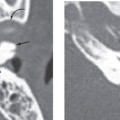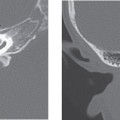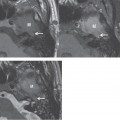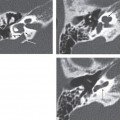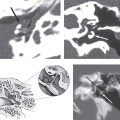CHAPTER 25 Schwannoma
Epidemiology
Facial nerve schwannomas are found in 5% of all patients who present with a facial nerve palsy. Although facial nerve schwannomas can arise anywhere along the facial nerve from the brainstem to the parotid gland, the most commonly involved portions of the nerve are within the temporal bone, specifically the geniculate, tympanic, second genu (region of facial nerve recess), and mastoid regions. Along with hemangiomas, schwannomas are the most common tumors of the facial nerve canal; 0.8% of all petrous temporal bone tumors are schwannomas. Intratemporal facial nerve schwannomas are more common than internal auditory canal facial nerve schwannomas. Less than 10% of seventh nerve schwannomas arise in the parotid gland. These tumors can arise in patients of any age, although the age range of 30 to 40 years is most commonly affected.
Clinical Features
Presenting symptoms depend on the location of the lesion. When arising within the temporal bone, facial nerve dysfunction (e.g., palsy) due to compression of the facial nerve is usually seen (50 to 90% of patients). When occurring as a tympanic cavity lesion (which is the most frequent location for these tumors), they can erode the ossicles resulting in conductive hearing loss (60 to 70% of patients). Symptom onset is usually gradual, but rarely can be acute and even intermittent. When lesions arise in the internal auditory canal, patients may present with sensorineural hearing loss with or without facial nerve dysfunction. Intraparotid seventh nerve schwannomas do not compress the facial nerve and present as an asymptomatic parotid mass.
Pathology
Facial nerve schwannomas, like schwannomas elsewhere, are benign peripheral nervous system tumors arising from the perineural lining cells—the nerve sheath (Schwann) cells. Histologically, regions of Antoni A (more cellularity) and Antoni B (less cellularity) tissue are seen. Tumors usually extend away from the nerve, which is why they are asymptomatic when arising in the soft parotid gland. However, in the confining intratemporal facial nerve canal, even when these tumors are small, symptomatic compression of the facial nerve can occur.
Treatment
Due to risks of injuring the facial nerve and the benign nature of these tumors, conservative therapy with serial imaging is the usual management with decompressive surgery (resection of tumor with nerve grafting as necessary) reserved for those who develop higher grade facial paralyses.
Imaging Findings
Stay updated, free articles. Join our Telegram channel

Full access? Get Clinical Tree


